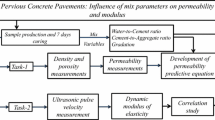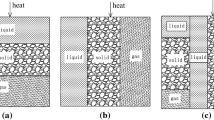Abstract
The aim of this study is to define an experimental model to predict acoustic absorption properties of porous asphalt concretes (PAC) as a function of composition and volumetric characteristics of mixes. The model can be used for the mix design of PAC and it enables to individuate which composition parameters to operate on in order to obtain optimum acoustic performances of low noise porous pavements. In order to define the experimental model, a large number of asphalt concrete samples, with high void content and composed of both different aggregate grading and different bitumen percentages were compacted in laboratory. Noise absorption spectra were determined on these samples by means of the stationary wave impedance tube. The measured amplitudes of the acoustic absorption spectrum were fitted by the Neithalath microstructural model in order to determine, for each sample, the pore geometry which allows to reproduce the measured acoustic absorption spectrum. After that, the pore geometry was related to composition and volumetric characteristics of mixes by means of multivariate regression techniques. By this way, the acoustic absorption spectrum of PAC can be predicted as function of specific composition parameters.













Similar content being viewed by others
References
Sandberg U, Ejsmont JA (2002) Tyre/road noise reference book. Informex Ejsmont & Sandberg Handelsbolag, Kisa
von Meier A (1992) Thin porous surface layers: design principles and results obtained. Proceedings of Eurosymposium The Mitigation of Traffic Noise in Urban Areas, LCPC, Nantes
Neithalath N (2004) Development and characterization of acoustically efficient cementitious materials. PhD Thesis, Purdue University, West Lafayette, p 242
Neithalath N, Marolf A, Weiss J, Olek J (2005) Modeling the influence of pore structure on the acoustic absorption of enhanced porosity concrete. J Adv Concr Technolo 3(1):29–40
Beranek L (1954) Acoustics. Acoustical Society of America, Woodbury
Delany ME, Bazley EN (1971) Acoustics proprieties of fibrous absorbent materials. Appl Acoust 3:105–116
Rayleigh JW (1929) Theory of sound, vol II. Macmillan, London
Zwikker C, Kosten CW (1949) Sound absorbing materials,. Elsevier Publishing Company, New York
Bérengier M, Hamet JF (1990) Propriétés acoustique des enrobés drainants. Bulletin Liaison Laboratoire Ponts et Chaussées. Réf. 3502, Juil-Aoùt
Hubelt J (2003) Modeling of porous asphalt as extended reacting absorber using the transmission-line-matrix-method (TLM). Euronoise 2003, paper ID:SS28-211, Naples
Lu TJ, Chen F, He D (2000) Sound absorption of cellular metals with semi open cells. J Acoust Soc Am 180(4):1697–1709
Kang J, Fuchs HV (1999) Predicting the absorption of open weave textiles and micro-perforated membranes backed by an air space. J Sound Vib 220:905–920
Kim HK, Lee HK (2010) Acoustic absorption modeling of porous concrete considering the gradation and shape of aggregates and void ratio. J Sound Vib 329:866–879
Brennan MJ, To WM (2001) Acoustic properties of rigid frame porous materials: an engineering perspective. Appl Acoust 62:793–811
Wang X, Lu TJ (1999) Optimized acoustic properties of cellular solids. J Acoust Soc Am 106(2):756–765
D’Andrea A, Di Mascio P, Domenichini L, Ranzo A (1999) TINO prototype of a low noise asphalt. Proceedings of the first international colloquium on vehicle tyre road interaction. The noise emission. Paper 99.04, Rome
Centre de Recerches Routières (C.R.R.-R 61/87), Code de bonne pratique pour la formulation des enrobes bitumineux denses
Author information
Authors and Affiliations
Corresponding author
Rights and permissions
About this article
Cite this article
Losa, M., Leandri, P. A comprehensive model to predict acoustic absorption factor of porous mixes. Mater Struct 45, 923–940 (2012). https://doi.org/10.1617/s11527-011-9808-8
Received:
Accepted:
Published:
Issue Date:
DOI: https://doi.org/10.1617/s11527-011-9808-8




